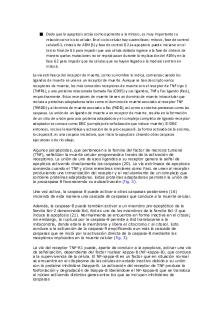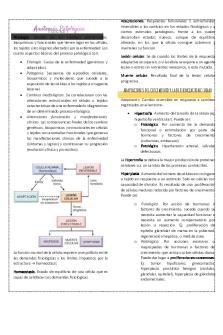Samali -apoptosis -Bcl-2 PDF

| Title | Samali -apoptosis -Bcl-2 |
|---|---|
| Author | Katelyn Kerrigan |
| Course | Molecular and Cellular Biology |
| Institution | National University of Ireland Galway |
| Pages | 2 |
| File Size | 54.9 KB |
| File Type | |
| Total Downloads | 287 |
| Total Views | 373 |
Summary
Discuss how the Bcl-2 family of proteins acts as the master regulators of the apoptotic cell death. A wide variety of pathological insults as well as internal and external physiological stimuli trigger apoptosis, a highly regulated process of cell death. Apoptosis is the natural form of cell death t...
Description
Discuss how the Bcl-2 family of proteins acts as the master regulators of the apoptotic cell death. A wide variety of pathological insults as well as internal and external physiological stimuli trigger apoptosis, a highly regulated process of cell death. Apoptosis is the natural form of cell death that ensues a homeostatic balance between cellular proliferation and turnover in tissues. Apoptosis removes cells (without inducing inflammation) generated in excess, have already completed their specific functions, are improperly formed or that are harmful to the organism. The main morphological changes of a cell undergoing apoptosis consist of cell shrinkage, membrane blebbing, condensation of the nuclear chromatin, cleavage of chromosomal DNA and fragmentation of the nucleus. Thus apoptosis results in the rapid and efficient removal of cells. Apoptosis follows 3 distinct steps (1) initiation- the decision of cells to kill themselves (2) execution - cells commit to die and activate machinery for cellular disassembly (3) clearance - apoptotic/cell bodies removed from the system. A key component in the mechanism of apoptosis is the activation of caspases, a family of proteases that participate in a cascade of events, which ultimately cleave a set of proteins and cause the disassembly of cells. The caspase proteolytic cascade represents a central point in the apoptotic response, however its initiation is tightly regulated by a variety of factors and in particular the Bcl-2 family. The Bcl-2 gene was first discovered in the human b-cell lymphomas (sequence of ced-9 has significant homology with human Bcl-2 gene). Translocation of the Bcl-2 gene to a different chromosome, in human B cell lymphoma, increased its activity and promoted cell survival and so it was established to be a proto-oncogene that prolongs cell survival by inhibiting apoptosis. Bcl-2 family proteins contain over 20 proteins and those closely related to Bcl-2 inhibit apoptosis, however more distantly related proteins promote apoptosis. The balance between these competing proteins determine the fate of cells. The Bcl-2 family members have at least one of the four conserved motifs (BH1, BH2, BH3, BH4). the majority are prosurvival (ced-9 like) e.g, Bcl-2, Bcl-Xl, Mcl-1 etc, which have all four domains. Pro-apoptotic members include Bax and Bak which have BH1, BH2 and BH3 domains, and also BH3-only members such as BIM, PUMA and BID (Eg1-like). The BH3-only domain is presumed a critical death domain, as all members with only the BH3 domain are pro-apoptotic. Bcl-2 and Bcl-Xl proteins are localised to the cytoplasmic face of the mitochondrial membrane, the nuclear envelope and the ER. the multidomain pro-apoptotic Bax is located in the cytosol before an apoptotic stimulus translocates it to the mitochondria, it can also be translocated to the ER upon stimulus. Bak is alway membrane bound, either at the mitochondria or the ER. the BH3-only members are either not expressed in non-apoptotic cells or bound to the cytoskeleton. If produced or released from the cytoskeleton, they bind to and inhibit the anti-apoptotic Bcl-2 proteins and thus unleash the pro-apoptotic members. Mechanism of the intrinsic/mitochondrial apoptotic pathway Mitochondria play an essential role in activating caspase proteases through a pathway termed the mitochondrial pathway or the intrinsic pathway of apoptosis. Mitochondria regulate caspase activation through a process called mitochondrial outer membrane permeabilization (MOMP) = cell death. Because of its pivotal role in dictating cell death, MOMP is highly regulated mainly through the interactions between pro- and anti-apoptotic members of the Bcl-2 family.
Upon stress the BH3-only proteins are expressed or activated (released from the cytoskeleton). The BH3-only proteins bind to anti-apoptotic Bcl-2 proteins such as Bcl-2 and Bcl-xL resulting in the release of the multidomain pro-apoptotic Bcl-2 Bax and Bak proteins. Bax and Bak undergo dramatic structural changes leading to the mitochondrial targeting of Bax and homo-oligomerization of Bak and Bax. this oligomerization is essential for MOMP and leads to the formation of megachannels in the outer mitochondrial membrane. It is through these mitochondrial permeability transition pore complexes which are formed by outer membrane rupture, that cytochrome c is released into the cytosol. Once in the cytoplasm, cytochrome c is transiently binds to the key caspase adaptor molecule Apaf-1. This causes the oligomerization of Apaf-1 to form a heptameric wheel-like structure with exposed caspase activation and recruitment domains (CARD). The Apaf-1 CARD domains bind to CARD domains of the initiator caspase pro-caspase-9, to form a complex called the apoptosome. At the apoptosome, dimerization of procaspase-9 leads to its activation, which in turn cleaves and activates the executioner caspase-3 and -7 leading to rapid cell death. High levels of Bcl-2 prevent release of cytochrome c from mitochondria. Bcl-2: directly interacts and block pore forming by pro-apoptotic family members, Bax and Bak. It also inhibits the BH3-only members to activate Bax and Bak and prevents the opening of the PTP – prevents mitochondrial swelling and cytochrome c release....
Similar Free PDFs

Samali -apoptosis -Bcl-2
- 2 Pages

Apoptosis Celular
- 6 Pages

Tipos de apoptosis
- 5 Pages

Apoptosis - Summary Cell Biology
- 4 Pages

1 Apoptosis Vs Necrosis
- 3 Pages

Apoptosis y Muerte Somática
- 18 Pages

Exam questions for apoptosis
- 3 Pages

Vía extrínseca de la apoptosis
- 1 Pages
Popular Institutions
- Tinajero National High School - Annex
- Politeknik Caltex Riau
- Yokohama City University
- SGT University
- University of Al-Qadisiyah
- Divine Word College of Vigan
- Techniek College Rotterdam
- Universidade de Santiago
- Universiti Teknologi MARA Cawangan Johor Kampus Pasir Gudang
- Poltekkes Kemenkes Yogyakarta
- Baguio City National High School
- Colegio san marcos
- preparatoria uno
- Centro de Bachillerato Tecnológico Industrial y de Servicios No. 107
- Dalian Maritime University
- Quang Trung Secondary School
- Colegio Tecnológico en Informática
- Corporación Regional de Educación Superior
- Grupo CEDVA
- Dar Al Uloom University
- Centro de Estudios Preuniversitarios de la Universidad Nacional de Ingeniería
- 上智大学
- Aakash International School, Nuna Majara
- San Felipe Neri Catholic School
- Kang Chiao International School - New Taipei City
- Misamis Occidental National High School
- Institución Educativa Escuela Normal Juan Ladrilleros
- Kolehiyo ng Pantukan
- Batanes State College
- Instituto Continental
- Sekolah Menengah Kejuruan Kesehatan Kaltara (Tarakan)
- Colegio de La Inmaculada Concepcion - Cebu







